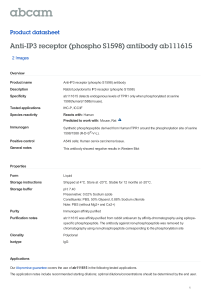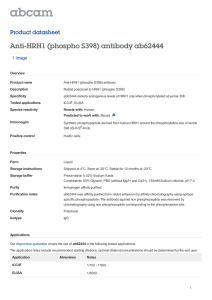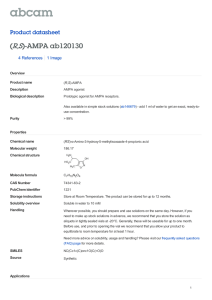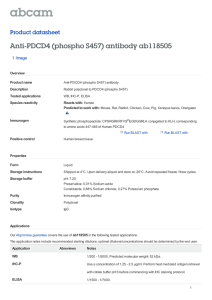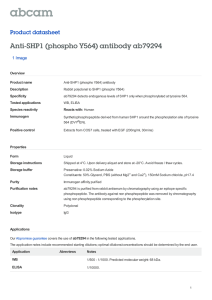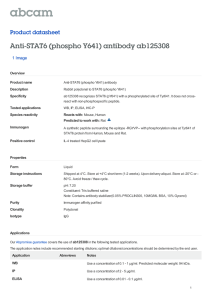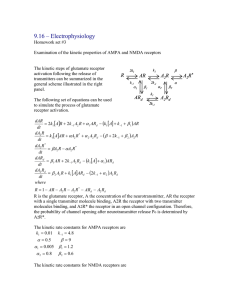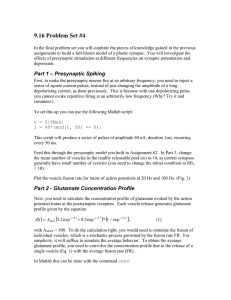Anti-Glutamate Receptor 1 (AMPA subtype) (phospho S849) antibody ab51063
advertisement
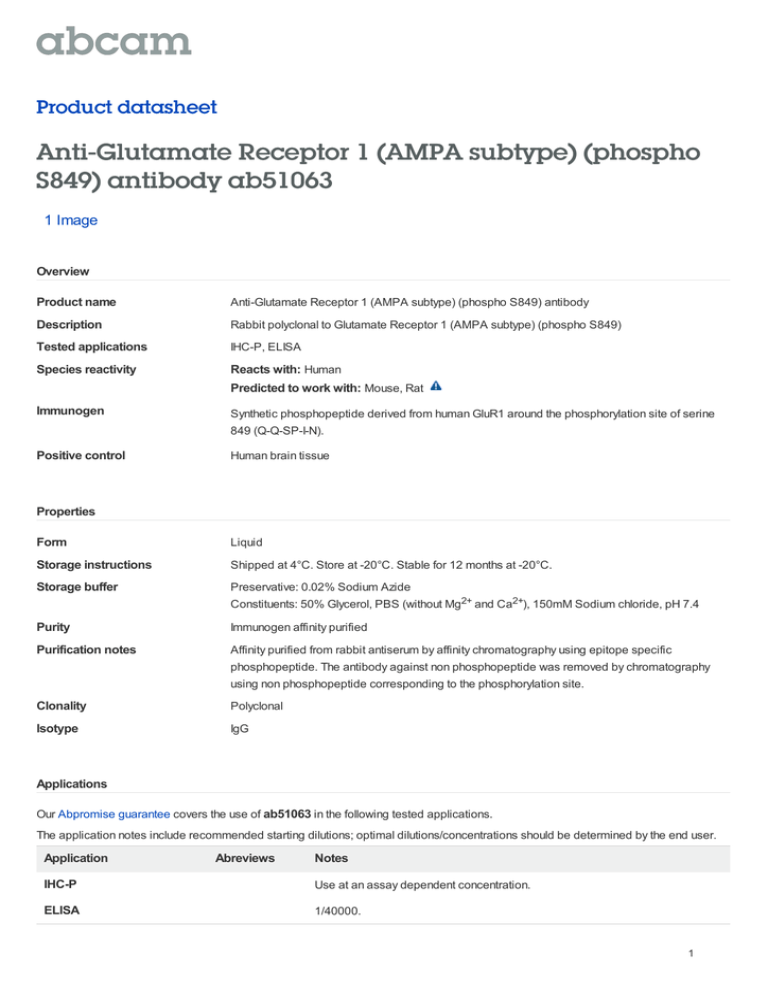
Product datasheet Anti-Glutamate Receptor 1 (AMPA subtype) (phospho S849) antibody ab51063 1 Image Overview Product name Anti-Glutamate Receptor 1 (AMPA subtype) (phospho S849) antibody Description Rabbit polyclonal to Glutamate Receptor 1 (AMPA subtype) (phospho S849) Tested applications IHC-P, ELISA Species reactivity Reacts with: Human Predicted to work with: Mouse, Rat Immunogen Synthetic phosphopeptide derived from human GluR1 around the phosphorylation site of serine 849 (Q-Q-SP-I-N). Positive control Human brain tissue Properties Form Liquid Storage instructions Shipped at 4°C. Store at -20°C. Stable for 12 months at -20°C. Storage buffer Preservative: 0.02% Sodium Azide Constituents: 50% Glycerol, PBS (without Mg2+ and Ca2+), 150mM Sodium chloride, pH 7.4 Purity Immunogen affinity purified Purification notes Affinity purified from rabbit antiserum by affinity chromatography using epitope specific phosphopeptide. The antibody against non phosphopeptide was removed by chromatography using non phosphopeptide corresponding to the phosphorylation site. Clonality Polyclonal Isotype IgG Applications Our Abpromise guarantee covers the use of ab51063 in the following tested applications. The application notes include recommended starting dilutions; optimal dilutions/concentrations should be determined by the end user. Application Abreviews Notes IHC-P Use at an assay dependent concentration. ELISA 1/40000. 1 Target Function Ionotropic glutamate receptor. L-glutamate acts as an excitatory neurotransmitter at many synapses in the central nervous system. Binding of the excitatory neurotransmitter L-glutamate induces a conformation change, leading to the opening of the cation channel, and thereby converts the chemical signal to an electrical impulse. The receptor then desensitizes rapidly and enters a transient inactive state, characterized by the presence of bound agonist. Tissue specificity Widely expressed in brain. Sequence similarities Belongs to the glutamate-gated ion channel (TC 1.A.10.1) family. GRIA1 subfamily. Post-translational modifications Palmitoylated. Depalmitoylated upon glutamate stimulation. Cys-603 palmitoylation leads to Golgi retention and decreased cell surface expression. In contrast, Cys-829 palmitoylation does not affect cell surface expression but regulates stimulation-dependent endocytosis. Cellular localization Cell membrane. Endoplasmic reticulum membrane. Cell junction > synapse > postsynaptic cell membrane. Interaction with CACNG2 promotes cell surface expression. Anti-Glutamate Receptor 1 (AMPA subtype) (phospho S849) antibody images Human brain tissue labelled with ab51063 at 1/50 dilution. Immunohistochemistry (Paraffin-embedded sections) - Glutamate Receptor 1 (AMPA subtype) (phospho S849) antibody (ab51063) Please note: All products are "FOR RESEARCH USE ONLY AND ARE NOT INTENDED FOR DIAGNOSTIC OR THERAPEUTIC USE" Our Abpromise to you: Quality guaranteed and expert technical support Replacement or refund for products not performing as stated on the datasheet Valid for 12 months from date of delivery Response to your inquiry within 24 hours We provide support in Chinese, English, French, German, Japanese and Spanish Extensive multi-media technical resources to help you We investigate all quality concerns to ensure our products perform to the highest standards If the product does not perform as described on this datasheet, we will offer a refund or replacement. For full details of the Abpromise, please visit http://www.abcam.com/abpromise or contact our technical team. Terms and conditions Guarantee only valid for products bought direct from Abcam or one of our authorized distributors 2
